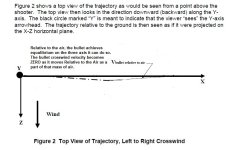Ultimately we are talking about deflection--the specific mechanism and magnitude may be complex to characterize, but it all comes down to something that starts off on one path ending up not traveling the original path. So it had to be deflected at some point and in some manner.
Given an isolated occurrence that generates deflection (say a gust of wind), the earlier in the trajectory that occurs, the greater the magnitude of the result on target. If the bullet is "knocked off" its initial course very early in the trajectory, it will follow the new course for a longer distance resulting in being farther off target than if it were given a new course just before it hits the target.
Given a constant input that generates deflection (constant wind), the longer that happens the greater the magnitude of the result on target.
Given an isolated occurrence that generates deflection (say a gust of wind), the earlier in the trajectory that occurs, the greater the magnitude of the result on target. If the bullet is "knocked off" its initial course very early in the trajectory, it will follow the new course for a longer distance resulting in being farther off target than if it were given a new course just before it hits the target.
Given a constant input that generates deflection (constant wind), the longer that happens the greater the magnitude of the result on target.
It's worth noting that even if one takes the "bullet in the air mass" interpretation, the bullet can't instantly acquire the speed of the air mass--in fact there might not be time for it to fully do that before reaching the target.It does not--the air mass it is entrained in has a sideways movement relative to the fixed objects on the ground.

